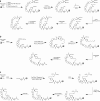Cyclic peptides targeting the SARS-CoV-2 programmed ribosomal frameshifting RNA from a multiplexed phage display library
- PMID: 39568906
- PMCID: PMC11575553
- DOI: 10.1039/d4sc04026k
Cyclic peptides targeting the SARS-CoV-2 programmed ribosomal frameshifting RNA from a multiplexed phage display library
Abstract
RNA provides the genetic blueprint for many pathogenic viruses, including SARS-CoV-2. The propensity of RNA to fold into specific tertiary structures enables the biomolecular recognition of cavities and crevices suited for the binding of drug-like molecules. Despite increasing interest in RNA as a target for chemical biology and therapeutic applications, the development of molecules that recognize RNA with high affinity and specificity represents a significant challenge. Here, we report a strategy for the discovery and selection of RNA-targeted macrocyclic peptides derived from combinatorial libraries of peptide macrocycles displayed by bacteriophages. Specifically, a platform for phage display of macrocyclic organo-peptide hybrids (MOrPH-PhD) was combined with a diverse set of non-canonical amino acid-based cyclization modules to produce large libraries of 107 structurally diverse, genetically encoded peptide macrocycles. These libraries were panned against the -1 programmed ribosomal frameshifting stimulatory sequence (FSS) RNA pseudoknot of SARS-CoV-2, which revealed specific macrocyclic peptide sequences that bind this essential motif with high affinity and selectivity. Peptide binding localizes to the FSS dimerization loop based on chemical modification analysis and binding assays and the cyclic peptides show specificity toward the target RNA over unrelated RNA pseudoknots. This work introduces a novel system for the generation and high-throughput screening of topologically diverse cyclopeptide scaffolds (multiplexed MOrPH-PhD), and it provides a blueprint for the exploration and evolution of genetically encoded macrocyclic peptides that target specific RNAs.
This journal is © The Royal Society of Chemistry.
Conflict of interest statement
There are no conflicts to declare.
Figures






Similar articles
-
MOrPH-PhD: A Phage Display System for the Functional Selection of Genetically Encoded Macrocyclic Peptides.Methods Mol Biol. 2022;2371:261-286. doi: 10.1007/978-1-0716-1689-5_14. Methods Mol Biol. 2022. PMID: 34596853 Free PMC article.
-
MOrPH-PhD: An Integrated Phage Display Platform for the Discovery of Functional Genetically Encoded Peptide Macrocycles.ACS Cent Sci. 2020 Mar 25;6(3):368-381. doi: 10.1021/acscentsci.9b00927. Epub 2020 Feb 4. ACS Cent Sci. 2020. PMID: 32232137 Free PMC article.
-
A facile strategy for the construction of a phage display cyclic peptide library for the selection of functional macrocycles.Chem Sci. 2024 Jul 1;15(30):11847-11855. doi: 10.1039/d4sc03207a. eCollection 2024 Jul 31. Chem Sci. 2024. PMID: 39092106 Free PMC article.
-
Synthesis of macrocyclic organo-peptide hybrids from ribosomal polypeptide precursors via CuAAC-/hydrazide-mediated cyclization.Methods Mol Biol. 2015;1248:23-38. doi: 10.1007/978-1-4939-2020-4_2. Methods Mol Biol. 2015. PMID: 25616323 Free PMC article. Review.
-
Biosynthetic Strategies for Macrocyclic Peptides.Molecules. 2021 Jun 1;26(11):3338. doi: 10.3390/molecules26113338. Molecules. 2021. PMID: 34206124 Free PMC article. Review.
Cited by
-
Copper-catalysed azide-alkyne cycloaddition on live M13 bacteriophage for expanding the molecular diversity of phage-displayed peptide libraries.RSC Chem Biol. 2025 Aug 14. doi: 10.1039/d5cb00140d. Online ahead of print. RSC Chem Biol. 2025. PMID: 40843438 Free PMC article.
-
Natural and Designed Cyclic Peptides as Potential Antiviral Drugs to Combat Future Coronavirus Outbreaks.Molecules. 2025 Apr 8;30(8):1651. doi: 10.3390/molecules30081651. Molecules. 2025. PMID: 40333520 Free PMC article. Review.
References
-
- Morris K. V. Mattick J. S. The rise of regulatory RNA. Nat. Rev. Genet. 2014;15(6):423–437. doi: 10.1038/nrg3722. https://dx.doi.org/10.1038/nrg3722 - DOI - DOI - PMC - PubMed
-
- St Laurent G. Wahlestedt C. Kapranov P. The Landscape of long noncoding RNA classification. Trends Genet. 2015;31(5):239–251. doi: 10.1016/j.tig.2015.03.007. https://dx.doi.org/10.1016/j.tig.2015.03.007 - DOI - DOI - PMC - PubMed
-
- Ebbesen K. K. Kjems J. Hansen T. B. Circular RNAs: Identification, biogenesis and function. Biochim. Biophys. Acta. 2016;1859(1):163–168. doi: 10.1016/j.bbagrm.2015.07.007. https://dx.doi.org/10.1016/j.bbagrm.2015.07.007 - DOI - DOI - PubMed
-
- Disney M. D. Dwyer B. G. Childs-Disney J. L. Drugging the RNA World. Cold Spring Harbor Perspect. Biol. 2018;10(11):a034769. doi: 10.1101/cshperspect.a034769. https://dx.doi.org/10.1101/cshperspect.a034769 - DOI - DOI - PMC - PubMed
-
- Cech T. R. Steitz J. A. The noncoding RNA revolution-trashing old rules to forge new ones. Cell. 2014;157(1):77–94. doi: 10.1016/j.cell.2014.03.008. https://dx.doi.org/10.1016/j.cell.2014.03.008 - DOI - DOI - PubMed
Grants and funding
LinkOut - more resources
Full Text Sources
Miscellaneous

